

2016 MAR 11

The outline of 2003 SD2020, an asteroid at least 3,600 feet (1,100 meters) long, is visible in this NASA radar image released on December 23. The object was imaged from a distance of about 7.3 million miles (12 million kilometers) using NASA's 230-foot (70-meter) Deep Space Network antenna at Goldstone, California. The asteroid safely flew past Earth on Thursday, Dec. 24, at a distance of 6.8 million miles (11 million kilometers). Credits: NASA/JPL-Caltech/GSSR
(DEC 24) NASA has cancelled the launch of its next Mars mission because a key instrument could not be repaired and tested before the 2016 launch opportunity closes.
Plans called for an Atlas V rocket to lift off from Vandenberg AFB and send the InSight lander and two prototype communcations satellites to the Red Planet.
A leak was discovered in a container designed keep the sensors for the lander's seismic instrument in a vacuum. The sensors must operate in a vacuum to allow the instrument to measure ground movements as small as the diameter of an atom.
Launch opportunities for Mars missions occur for a few weeks every 26 months. The opportunity for the InSight mission is March 4 to March 30.
The InSight lander recently arrived at Vandenberg AFB. However, because of the cancellation, the spacecraft will be returned to Lockheed Martin in Denver, Colorado.
Brian Webb
(DEC 17) Moffett Field, Calif. - NASA scientists have released new findings about the moon's tenuous exosphere - the thin layer of gas surrounding the moon that is one 25-trillionth the density of Earth's atmosphere. More
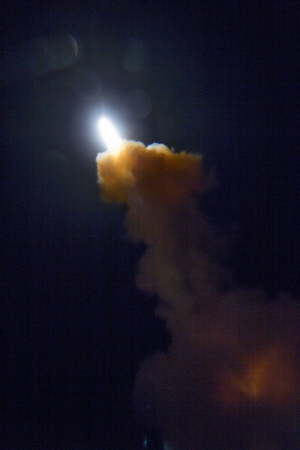
An SM-3 missile lifts off from San Nicolas Island, Calif. on the morning of December 8. Image courtesy U.S. Missile Defense Agency
(DEC 10) The U.S. and Japan conducted an unannounced missile launch near the California coast on the morning of December 8. The SM-3 lifted off from San Nicolas Island at 6 a.m. and produced a mysterious glowing cloud in the dawn sky that was seen over a wide area. Several hours later, the U.S. Missile Defense Agency issued the following statement about the launch:
"The Japan Ministry of Defense (MOD) Acquisition, Technology and Logistics Agency (ATLA) and the U.S. Missile Defense Agency (MDA), in cooperation with the U.S. Navy, announced the successful completion of a Standard Missile-3 (SM-3) Block IIA flight test from the Point Mugu Sea Range, San Nicolas Island, California. This test, designated SM-3 Block IIA Cooperative Development Controlled Test Vehicle-02, was a live fire of the SM-3 Block IIA. The missile successfully demonstrated flyout through kinetic warhead ejection. No intercept was planned, and no target missile was launched.
Program officials will evaluate system performance based upon telemetry and other data obtained during the test.
The SM-3 Cooperative Development Project is the joint U.S.-Japan development of a 21-inch diameter variant of the SM-3, designated Block IIA, to defeat medium- and intermediate-range ballistic missiles. Aegis Ballistic Missile Defense (BMD) is the naval component of the U.S. Ballistic Missile Defense System (BMDS). The MDA and the U.S. Navy cooperatively manage the Aegis BMD program."
Brian Webb
(DEC 4) An instrument problem has raised concerns whether NASA's next Mars mission can launch as scheduled from Vandenberg AFB on March 4.
An Atlas V rocket is slated to lift off from the California coast and send the InSight lander and two prototype communications satellites to the Red Planet.
After a sphere that holds seismometers for the lander's seismic instrument was evacuated and sealed, a leak was detected. The seismometers must operate in a vacuum to provide extreme the sensitivity required to detect extremely small ground motion.
The French space agency is working to fix the problem before the instrument is shipped to Vandenberg for integration with the InSight lander. NASA and the French space agency are committed to a March launch.
Brian Webb
(NOV 23) SACRAMENTO, Calif. - Aerojet Rocketdyne, a subsidiary of Aerojet Rocketdyne Holdings, Inc. (NYSE: AJRD), was awarded a contract by NASA to restart production of the RS-25 engine for the Space Launch System (SLS), the most powerful rocket in the world and designed for the Journey to Mars.
The $1.16 billion contract, which runs from November 2015 through Sept. 30, 2024, is to restart the production line for the RS-25 engine. These production lines have been significantly improved and made more efficient since the retirement of the space shuttle program.
Aerojet Rocketdyne is the prime contractor for the RS-25, and four of these engines will fly on the bottom of the core stage of the SLS rocket, together producing more than two million pounds of thrust.
The first flight test of the SLS is slated for 2018, and it will be configured for a 70-metric-ton lift capacity and carry an uncrewed Orion spacecraft. As SLS evolves, it will be the most powerful rocket ever built and provide an unprecedented lift capability of 130 metric tons.
The new engines will incorporate simplified, yet highly reliable, designs to reduce manufacturing time and cost. For example, the overall engine is expected to simplify key components with dramatically reduced part count and number of welds. At the same time, the engine is being certified to a higher operational thrust level.
Aerojet Rocketdyne
(NOV 18) A $4.1 million dollar NASA award will allow New Mexico State University to continue operating the Atmospheres Node of NASA's Planetary Data System (PDS) for the next five years. More
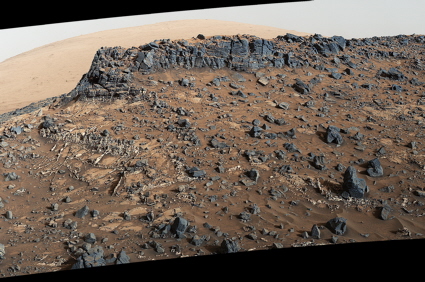
This portion of a view from the Mast Camera (Mastcam) on NASA's Curiosity Mars rover released November 13 shows a site with a network of prominent mineral veins below a cap rock ridge on lower Mount Sharp. Mineral veins such as these form where fluids move through fractured rocks, depositing minerals in the fractures and affecting chemistry of the surrounding rock. Malin Space Science Systems, San Diego, built and operates the rover's Mastcam. Image courtesy NASA/JPL-Caltech/MSSS
(NOV 14) A NASA rocket is scheduled for launch from the New Mexico desert early on the morning of November 16.
The Black Brant IX rocket is slated to lift off from White Sands Missile Range at 12:30 a.m. Mountain Time and carry an experimental telescope from the University of Massachusetts at Lowell to the edge of space.
The instrument will collect images of the space around the star Epsilon Eridani before the rocket falls back to Earth and lands by parachute.
If the sky is clear, the launch could be visible to the naked eye for several miles.
Brian Webb
(NOV 8) The unusual light show observed last night from California and outlying areas was the unannounced launch of an unarmed Trident II (D5) submarine launched ballistic missile. The Trident was launched off of the southern California coast by the submarine USS Kentucky.
The interesting display was caused by the missile's exhaust plume being illuminated at high altitude by the Sun's rays after the sun had set for observers on the ground.
Trident launches occur off of the California coast from time to time. However, the Navy does not announce in advance that a launch is scheduled.
Brian Webb
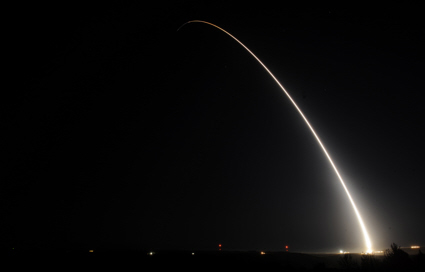
A Minuteman III strategic missile heads downrange following launch from Vandenberg AFB on October 21. U.S. Air Force photo by Airman 1st Class Ian Dudley
(OCT 21) VANDENBERG AIR FORCE BASE, Calif. - A team of Air Force Global Strike Command Airmen from the 90th Missile Wing at F.E. Warren Air Force Base, Wyoming, launched an unarmed Minuteman III intercontinental ballistic missile equipped with a test reentry vehicle today at 5:45 a.m. Pacific Daylight Time from Vandenberg Air Force Base, Calif. More
(OCT 14) WASHINGTON, DC - NASA's Launch Services Program (LSP) has awarded multiple Venture Class Launch Services (VCLS) contracts to provide small satellites (SmallSats) -- also called CubeSats, microsats or nanosatellites -- access to low-Earth orbit.
The three companies selected to provide these new commercial launch capabilities, and the value of their firm fixed-price contracts, are:
At present, launch opportunities for small satellites and science missions mostly are limited to rideshare-type arrangements, flying only when space is available on NASA and other launches. The services acquired through these new contract awards will constitute the smallest class of launch services used by NASA.
Small satellites, including CubeSats, are playing an increasingly larger role in exploration, technology demonstration, scientific research and educational investigations at NASA. These miniature satellites provide a low-cost platform for NASA missions, including planetary space exploration; Earth observations; fundamental Earth and space science; and developing precursor science instruments like cutting-edge laser communications, satellite-to-satellite communications and autonomous movement capabilities.
NASA
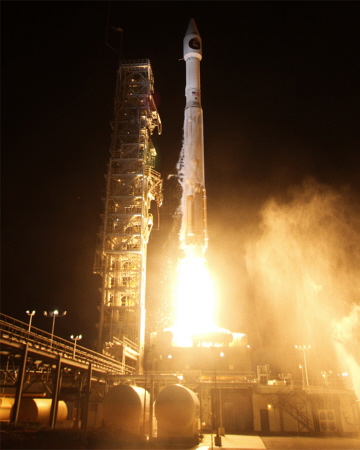
An Atlas V booster lifts off from Space Launch Complex 3 at Vandenberg AFB before dawn on October 8. The vehicle carried a classified national security payload and several small satellites into orbit. Image credit: United Launch Alliance
(OCT 8) VANDENBERG AIR FORCE BASE, Calif. - Team Vandenberg successfully launched the United Launch Alliance Atlas V rocket carrying a National Reconnaissance Office payload from Space Launch Complex-3 here Thursday, Oct. 8, at 5:49 a.m. PDT.
Col. J. Christopher Moss, 30th Space Wing commander, was the launch decision authority.
"This launch was an great achievement for Team Vandenberg, ULA, NRO and our launch partners," said Moss. "Their outstanding professionalism and team work ensured a fantastic launch and I am proud to work with this team of experts in support of national defense."
Vandenberg AFB
(OCT 1) Thirteen NASA and National Reconnaissance Office (NRO)-sponsored CubeSats are scheduled to launch aboard a United Launch Alliance Atlas V rocket Thursday, Oct. 8, from Vandenberg Air Force Base in California. More
(SEP 24) SANTA BARBARA, Calif. - The Westmont Observatory will host an informal gathering to view the lunar eclipse on Sunday, Sept. 27, beginning at 6:30 p.m. More
(SEP 16) TUCSON, Ariz. -- The Missile Defense Agency awarded Raytheon Company (NYSE: RTN) $87 million to purchase long-lead materials needed to produce up to 17 Standard Missile-3 Block IIAs that will be used for testing and initial deployment. A follow-on contract for the additional materials, parts and components is expected by early 2016.
"Our Japanese partners have been tremendous allies in this development program, and together we've taken ballistic missile defense to the next level," said Dr. Taylor W. Lawrence, Raytheon Missile Systems president. "When the SM-3 Block IIA deploys in 2018, we will have a greater degree of protection than ever before."
The SM-3 Block IIA has larger rocket motors and a bigger, more capable kill vehicle that allows it to take out threats sooner in flight and protect larger regions of land.
"The SM-3 Block IIA can be used at sea or on land with no modification to the missile," said Amy Cohen, Standard Missile-3 program director. "The SM-3 is the only ballistic missile defense interceptor that can be deployed both ways, and that flexibility is a tremendous asset."
The program is on track for both land and sea deployment in 2018 in line with Phase 3 of the U.S.'s Phased Adaptive Approach for missile defense of U.S. deployed forces and allies in NATO Europe.
Raytheon
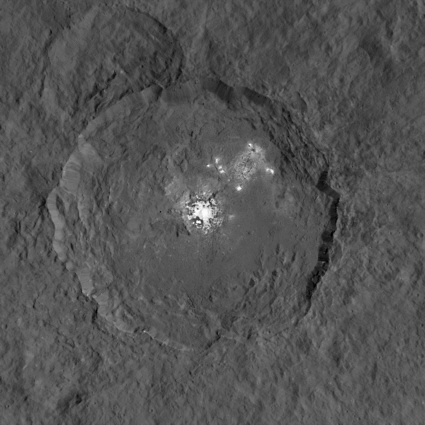
Several intriguing bright spots stand out in striking new detail in this recent Dawn spacecraft image of Occator crater on the asteroid Ceres. The image is a composite of images taken by Dawn during the mission's High Altitude Mapping Orbit (HAMO) phase, from which the spacecraft imaged the surface at a resolution of about 450 feet (140 meters) per pixel. The Dawn mission is managed by JPL in Pasadena, Calif. for NASA's Science Mission Directorate in Washington. Image credit: NASA/JPL-Caltech/UCLA/MPS/DLR/IDA
(SEP 11) The Defense Department will establish a Joint Interagency Combined Space Operations Center (JICSpOC), in conjunction with other organizations, to share information across the national security space enterprise. More
(SEP 2) COLORADO SPRINGS, Colo. -- Raytheon (NYSE: RTN) will speed up growth of its Colorado Springs presence after signing a $700 million multi-year indefinite-delivery/indefinite-quantity contract to support operations at NORAD's Cheyenne Mountain Complex.
Under the NORAD Integrated Space Support Contract (NISSC), Raytheon will provide 24/7 support to warning and attack assessment systems for air, missile and space threats. The contract was initially awarded to Raytheon in April 2015; however, protest activity delayed its execution. The Government Accountability Office denied the most recent protest on August 25.
Raytheon
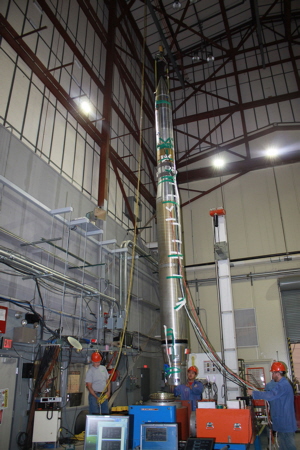
A sounding rocket is readied for vibration testing prior to launch from White Sands, NM. On August 27 the rocket successfully carried Montana State University's MOSES-2 instrument on a 15-minute flight into space. The Multi-Order Solar EUV Spectrograph, or MOSES-2 instrument was designed to image the sun in extreme ultraviolet light, a portion of the spectrum blocked by Earth's atmosphere. Photo courtesy of NASA
(AUG 25) Mars enthusiasts around the world can participate in NASA's journey to Mars by adding their names to a silicon microchip headed to the Red Planet aboard NASA's InSight Mars lander, scheduled to launch next year.
"Our next step in the journey to Mars is another fantastic mission to the surface," said Jim Green, director of planetary science at NASA Headquarters in Washington. "By participating in this opportunity to send your name aboard InSight to the Red Planet, you're showing that you're part of that journey and the future of space exploration."
Submissions will be accepted until Sept. 8.
To send your name to Mars aboard InSight, go to: http://go.usa.gov/3Aj3G
Jet Propulsion Laboratory
(AUG 19) BARKSDALE AIR FORCE BASE, La. -- It was 45 years to the day that the 91st Missile Wing at Minot Air Force Base, North Dakota, put the U.S. Air Force's first Minuteman III missiles on alert. More
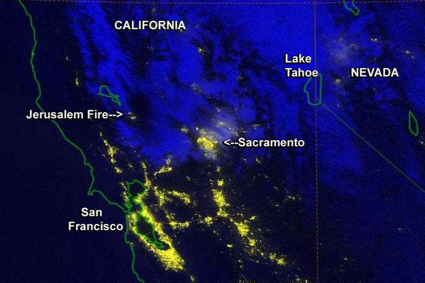
Several northern California cities and the Jerusalem wildfire are visible in this cropped nighttime image recorded by the Suomi NPP satellite at 1:10 a.m. PDT on August 10. The large area of city lights to the south of the fire is San Francisco. Sacramento's lights are southeast of the fire. Suomi NPP was launched from Vandenberg AFB, Calif. on 2011 October 28. Image Credit: Naval Research Laboratory/NASA/NOAA
(AUG 14) TUCSON, Ariz. -- The U.S. Missile Defense Agency awarded Raytheon Company (NYSE: RTN) a $9,775,608 competitive cost-plus-fixed-fee contract for a Multi-Object Kill Vehicle concept that can destroy several objects within a threat complex by considering advanced sensor, divert and attitude control and communication concepts.
"We fully support the Missile Defense Agency's goal of increasing the effectiveness and reliability of our homeland defense by exploring a wide range of capabilities against long-range ballistic missiles and using proven technologies combined with innovative designs," said Dr. Thomas Bussing, vice president of Advanced Missile Systems.
Raytheon will define critical functional aspects of the concept and propose risk mitigation activities by assessing the technical maturity of the concept, prioritizing and nominating risk reduction tasks for all critical components and describing how the tasks will reduce risk. In addition, a proof-of-concept prototype demonstration program will be defined.
The work will be performed in Tucson, AZ and Huntsville, AL, by Raytheon's Advanced Missiles product line with an estimated completion date of May 2016.
Raytheon
(AUG 7) NASA is launching an official Tumblr profile that will give Tumblr users a regular dose of space in a blog-like format through text, photos, videos and more.
Tumblr is a social media platform that allows users to connect and follow other content creators in a collaborative micro-blog format. People are able to discover, share and create content that expresses their personality, hobbies and interests. The NASA Tumblr profile will share information, images and video about the agency's missions of exploration and discovery.
To follow NASA's new Tumblr account, visit:
NASA
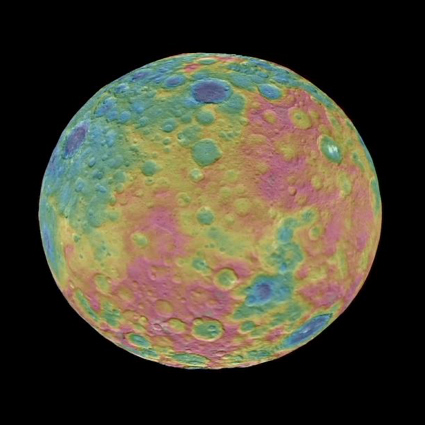
The topography of Ceres is visible in this false color image of the dwarf planet released by the Jet Propulsion Laboratory in Pasadena, Calif. on July 28. The topographic map was constructed by analyzing images from the Dawn spacecraft's framing camera taken from varying sun and viewing angles. The color scale extends 3.7 miles below the surface in purple to 3.7 miles above the surface in brown. The Dawn mission is managed by JPL for NASA's Science Mission Directorate in Washington, DC. Image credit: NASA/JPL-Caltech/UCLA/MPS/DLR/IDA/PSI
(JUL 17) New Mexico State University researchers are part of a team of scientists with the Sloan Digital Sky Survey (SDSS) who created a new map of the Milky Way that shows nearly a third of the stars have dramatically changed their obits. More
(JUL 24) The Falcon 9/Jason-3 launch that was tentatively scheduled for the evening of August 8th from Vandenberg AFB appears to have been delayed until the fall. The delay comes in the wake of a failed Falcon 9 rocket launch from Florida in late June.
For more information about the failed June launch and the Falcon 9 launch schedule, go to:
http://www.spacex.com/news/2015/07/20/crs-7-investigation-update
Brian Webb
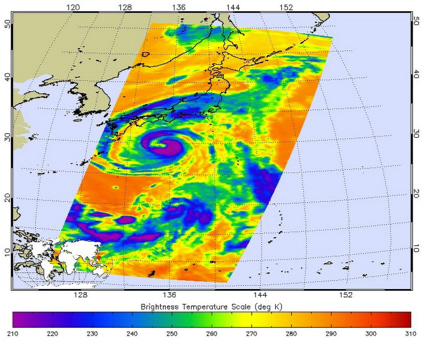
More than 13 years after liftoff from Vandenberg AFB, Calif., NASA's Aqua spacecraft continues to observe Earth's oceans, atmosphere, and land areas. Aqua recorded this thermal image of Typhoon Nangka during a pass over east Asia on July 15 at 16:35 UTC (9:35 a.m. PDT). Image courtesy of NASA JPL and Ed Olsen
(JUL 17) LOS ANGELES AIR FORCE BASE, El Segundo, Calif. - The U.S. Air Force Space and Missile Systems Center announced the delivery of the third Space Based Infrared System Geosynchronous Earth Orbit satellite into storage at the Lockheed Martin facility in Sunnyvale, Calif. More
(JUL 7) DENVER - A new development center will advance satellite sensing and communication technologies, broadly known as Radio Frequency (RF) payloads, at the Lockheed Martin (NYSE: LMT) facility in Denver. The RF Payload Center of Excellence will focus on developing reconfigurable payloads and advancing satellite systems that many already rely on, from high-def television broadcasts to GPS transmissions and secure government communications.
The RF Payload Center of Excellence reduces cost and accelerates development by uniting researchers, manufacturers and analysts in one organization. Bringing people together improves schedule, reduces transportation costs and enhances collaboration between related teams.
RF payload components are important for all space missions. In fact, one or more RF subsystems are embedded in every spacecraft Lockheed Martin produces. Using its partnerships with suppliers and research universities, the center will develop a variety of technologies commonly incorporated in RF payloads, such as antennas, arrays and transmitters for the full spectrum of bandwidth.
Lockheed Martin
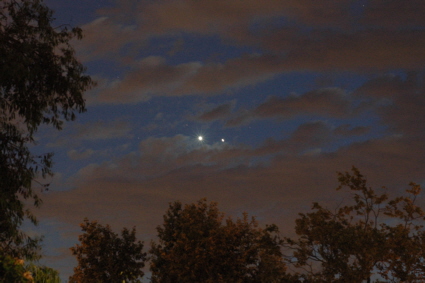
In late June and early July, sky watchers the world over were treated to a close dusk pairing of the planets Venus and Jupiter. The Webmaster photographed the planetary duo during breaks in the clouds on the evening of July 2 from Ventura County, Calif. Although Venus (left) and Jupiter (right) appeared to be close to one another, they were actually in different parts of the solar system. Copyright 2015, Brian Webb
(JUL 5) An in-flight abort test of SpaceX's Dragon spacecraft scheduled for this fall from Vandenberg AFB has been moved to Kennedy Space Center, Florida.
The unmanned test of the prototype manned vehicle was also delayed. The test is now planned to take place after the unmanned orbital test flight of a Dragon crew transport spacecraft.
Brian Webb
(JUN 26) TUCSON, Arizona - A journey that will stretch millions of miles and take years to complete begins with a short trip to a loading dock. More
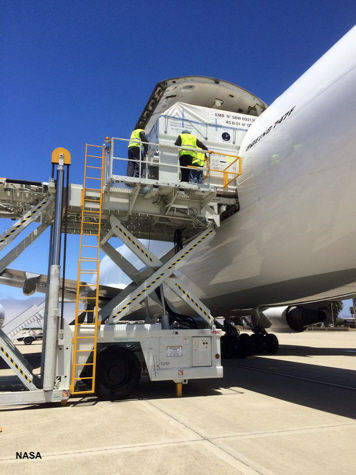
The Jason-3 spacecraft is unloaded from a 747 transport aircraft at Vandenberg Air Force Base, Calif., on June 18, concluding a journey from the Thales Alenia Space manufacturing facility in France. The Jason-3 satellite altimetry mission is scheduled to launch this August. Image courtesy of NASA
(JUN 15) Physicists plan a $6.4 million expansion of the $25 million Telescope Array observatory in Utah so they can zero in on a "hotspot" that seems to be a source of the most powerful particles in the universe: ultrahigh-energy cosmic rays. More
(JUN 12) SANTA BARBARA, Calif. - Jupiter, Venus and a small crescent moon come into alignment this month, but it may be views of Saturn that steal the show at a free public viewing of the stars Friday, June 19, at 8 p.m. at the Westmont Observatory. Jupiter and Venus and the moon form a skewed triangle that will be easily visible after sunset in the western sky. "It will be a real treat for the naked eye, but not one that will fit into the field of view of Westmont's telescopes," says Thomas Whittemore, Westmont physics instructor.
The best viewing generally occurs later in the evening. In case of inclement or overcast weather, please call the Telescope Viewing Hotline at (805) 565-6272 and check the Westmont website to see if the viewing has been canceled.
As the night goes on, Whittemore says he will aim the powerful Keck Telescope toward Saturn, which now lies to the west of Scorpius. "If the weather cooperates, we should be able to see the famous Cassini Division between the A and B rings, some banding on Saturn's surface and several moons," he says.
Westmont College
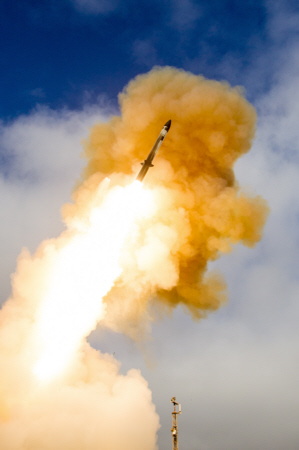
A Block IIA Standard Missile-3 (SM-3) lifts off from San Nicolas Island, Calif. on June 6. The launch was the first live fire of the SM-3 Block IIA, an interceptor designed to defeat medium- and intermediate-range ballistic missiles. During the test, the missile successfully demonstrated flyout through nosecone deployment and third stage flight. No intercept was planned, and no target missile was launched. Image courtesy U.S. Missile Defense Agency
(JUN 2) LOS ANGELES AIR FORCE BASE, El Segundo, Calif. - Today the Space and Missile Systems Center released a formal solicitation seeking proposals for shared public-private investments in rocket propulsion system prototypes. More
(MAY 26) VANDENBERG AIR FORCE BASE, Calif. -- A team of Air Force Global Strike Command Airmen launched an unarmed Minuteman III intercontinental ballistic missile equipped with a test reentry vehicle from Vandenberg Air Force Base, California, at 3:37 a.m. Pacific Daylight Time May 20. More
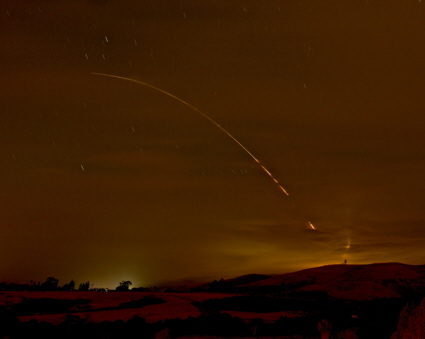
A Minuteman III missile arcs across the sky following launch from Vandenberg AFB early on the morning of May 20. Glenn Beltz recorded this time exposure of the launch from the Winchester Canyon area of Goleta, Calif. Image copyright 2015, Glenn Beltz. Used with permission.
(MAY 20) The U.S. Air Force and media sources report that a Minuteman III strategic missile was launched at 03:36 PDT this morning from Vandenberg AFB.
The launch was heard as far away as Pismo Beach. Clouds hampered launch viewing for many observers, but some were able to see the event. The most distant reported sighting of the launch was from Visalia, Calif.
Brian Webb
(MAY 18) VANDENBERG AIR FORCE BASE, Calif. - An operational test launch of an Air Force Global Strike Command unarmed Minuteman III intercontinental ballistic missile is scheduled for Wednesday, May 20, 2015, between 3:36 a.m. and 9:36 a.m. from north Vandenberg Air Force Base.
The purpose of the ICBM test launch program is to validate and verify the effectiveness, readiness and accuracy of the weapon system, according to Air Force Global Strike Command.
Col. Keith Balts, 30th Space Wing commander, is the Launch Decision Authority.
"The launch process requires tremendous teamwork and involves months of preparation," said Balts. "The data gained from these launches allows us to maintain a high readiness capability and ensures operational effectiveness of the most powerful weapons in the nation's arsenal."
The launch team, under the direction of the 576th Flight Test Squadron, includes crew members and maintainers from the 90th Missile Wing, F.E. Warren AFB, Wyoming.
Vandenberg AFB
(MAY 13) The University of New Mexico's Configurable Space Microsystems Innovations and Applications Center (COSMIAC) is preparing its third CubeSat, a small, cube-shaped satellite, for a space launch. More
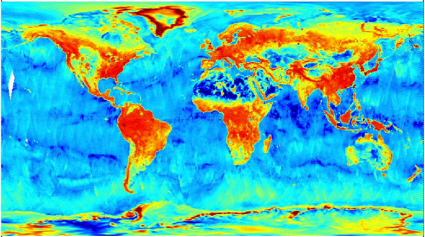
Less than two months after launch from Vandenberg AFB in California, NASA's Soil Moisture Active Passive (SMAP) spacecraft is returning global soil moisture data. This image was created from SMAP radar acquired from data March 31 to April 3. Weaker radar signals (blues) reflect low soil moisture or lack of vegetation, such as in deserts. Strong radar signals (reds) are seen in forests. SMAP's radar also takes data over the ocean and sea ice. Credit: NASA/JPL-Caltech/GSFC
(APR 21) TUCSON, Arizona - Are we alone? To get answers to one of humanity's oldest questions, NASA has selected an interdisciplinary research team led by the University of Arizona for a major grant in a new program focusing on the search for clues to life on faraway worlds. More
(APR 13) Colorado Springs, Colo., - United Launch Alliance (ULA) unveiled its Next Generation Launch System (NGLS) today at the 31st Space Symposium. More
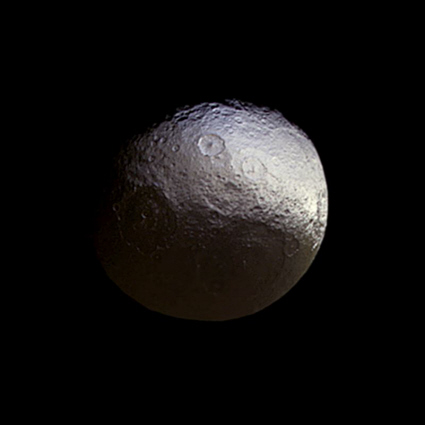
The subtle colors of Saturn's moon Iapetus are revealed in this composite image released on April 6. NASA's Cassini spacecraft observed the two-tone moon for about a week earlier this year in a campaign motivated in part to investigate subtle color differences within the moon's bright terrain. Images taken using red, green and blue spectral filters were combined to create this natural-color view. The moon's brightness has been enhanced in order to make the dark terrain visible. The Jet Propulsion Laboratory in Pasadena, Calif., manages the Cassini mission for NASA. Image and caption courtesy NASA/JPL-Caltech/Space Science Institute
(APR 6) SACRAMENTO, Calif. - Aerojet Rocketdyne, a GenCorp (NYSE: GY) company, has been awarded a contract worth approximately $18 million from NASA Glenn Research Center to complete the development of NASA's Evolutionary Xenon Thruster-Commercial (NEXT-C) Gridded Ion Thruster System. The NEXT-C Gridded Ion Thruster System is designed to power government and commercial spacecraft to deep-space destinations faster, farther and more fuel efficiently than any other propulsion technology currently available.
Under the contract, Aerojet Rocketdyne will complete the development of both the NEXT-C Gridded Ion Thruster System and power processing units (PPUs), and deliver two complete flight systems to NASA. The PPUs convert the electrical power generated by the solar arrays into the power needed for each component of the thruster.
According to NASA, the NEXT System is capable of performing a variety of missions to deep-space destinations such as Mars and the outer planets while reducing cost and trip time. In 2013, NASA completed a record-setting 50,000-hour lifetest of the NEXT-C Gridded Ion Thruster System, establishing the performance and lifetime capabilities required for a wide range of demanding missions. Operating at three times the power level of the current low-power NASA systems, the NEXT-C Gridded Ion Thruster System produces three times the thrust level. This higher-power operating capability enables commercial applications in addition to science missions.
Aerojet Rocketdyne
(MAR 31) NASA has announced the release of Vesta Trek, a free, web-based application that provides detailed visualizations of Vesta, one of the largest asteroids in our solar system.
NASA's Dawn spacecraft studied Vesta from July 2011 to September 2012. Data gathered from multiple instruments aboard Dawn have been compiled into Vesta Trek's user-friendly set of tools, enabling citizen scientists and students to study the asteroid's features. The application includes:
-- Interactive maps with the ability to overlay a growing range of data sets including topography, mineralogy, abundance of elements and geology, as well as analysis tools for measuring the diameters, heights and depths of surface features and more.
-- 3-D printer-exportable topography so users can print physical models of Vesta's surface.
-- Standard keyboard gaming controls to maneuver a first-person visualization of "flying" across the surface of the asteroid.
To explore Vesta Trek, visit:
http://vestatrek.jpl.nasa.gov/
NASA Ames Research Center
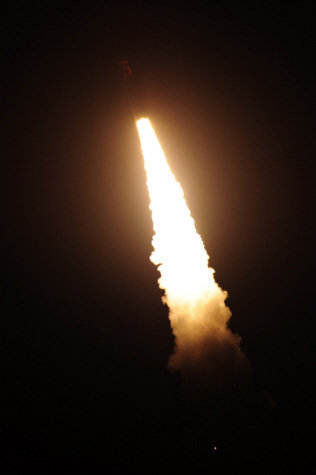
An unarmed Minuteman III intercontinental ballistic missile launches at 3:53 a.m. Pacific Daylight Time, March 27, 2015, at Vandenberg Air Force Base, Calif. Air Force Global Strike Command demonstrated the capabilities of their ICBM fleet and crew force with two test launches in less than a week. U.S. Air Force photo by Staff Sgt. Jim Araos
(MAR 27) VANDENBERG AIR FORCE BASE, Calif. - A team of Air Force Global Strike Command Airmen launched an unarmed Minuteman III intercontinental ballistic missile equipped with a test reentry vehicle today at 3:53 a.m. Pacific Daylight Time from Vandenberg Air Force Base, California.
The test reentry vehicle impacted in a pre-established test area in the Pacific Ocean near the island of Guam approximately 40 minutes after launch.
All test launches verify the accuracy and reliability of the ICBM weapon system, providing valuable data to ensure a safe, secure and effective nuclear deterrent. The launch team, under the direction of the 576th Flight Test Squadron, Vandenberg AFB, included Airmen from the 341st Missile Wing at Malmstrom AFB, Montana and was the second test launch of a Minuteman III this week. The 576th Flight Test Squadron and 90th Missile Wing, F.E. Warren AFB, Wyoming, completed the first unarmed Minuteman III launch of the week from Vandenberg AFB March 23.
"An operational test launch requires hard work, months of preparation, and outstanding teamwork between personnel on both bases," said Lt. Col. Daniel Hays, the 341st Missile Wing Task Force Commander. "These launches are a visible reminder to both our adversaries and our allies of the readiness and capability of the Minuteman III weapon system, and without the dedication of the men and women from both the 576th and the 341st, this test could not have happened."
"The two launches from the past week were a full team effort between the 576th, and the 90th and 341st Missile Wings," said Col. Kelvin Townsend, 576th Flight Test Squadron commander. "Launching multiple missiles in close proximity to each other adds an extra amount of realism to the operational test mission we fulfill here. These test launches occur due to the training and strict attention to detail our people have; resulting in a reliable test."
Malmstrom and Warren AFBs are two of three missile bases with crew members standing alert 24-7 year round, overseeing the nation's 450 ICBM alert forces.
The ICBM community, including the Department of Defense, the Department of Energy, and U.S. Strategic Command will use the data collected from this mission for continuing force development evaluation.
The ICBM test launch program demonstrates the operational credibility of the Minuteman III and ensures the United States' ability to maintain a strong, credible nuclear deterrent as a key element of U.S. national security and the security of U.S. allies and partners.
Air Force Global Strike Command
(MAR 23) VANDENBERG AIR FORCE BASE, Calif. - A team of Air Force Global Strike Command Airmen launched an unarmed Minuteman III intercontinental ballistic missile equipped with a test reentry vehicle today at 3:36 a.m. Pacific Daylight Time from Vandenberg Air Force Base, California.
Every test launch verifies the accuracy and reliability of the ICBM weapon system, providing valuable data to ensure a safe, secure and effective nuclear deterrent. The launch team, under the direction of the 576th Flight Test Squadron, Vandenberg AFB, included Airmen from the 90th Missile Wing at F. E. Warren AFB, Wyoming.
"A lot of work and preparation goes in to an operational test launch from the teams on both bases," said Lt. Col Tytonia Moore, 90th MW, Task Force commander. "With these launches, we not only verify our processes and the ICBM weapon system, we provide a visual to the world that the Minuteman III is capable of striking pretty much anywhere with extreme precision."
"The role we play here is vital to the testing and evaluation of the Minuteman III program," said Col. Kelvin Townsend, 576th Flight Test Squadron commander. "We ensure the facilities and framework are in place to conduct operational test launches in a safe and secure manner with multiple team players contributing to the reliability of the test."
F. E. Warren AFB is one of three missile bases with crew members standing alert 24-7 year round, overseeing the nation's 450 ICBM alert forces.
The ICBM community, including the Department of Defense, the Department of Energy, and U.S. Strategic Command will use the data collected from this mission for continuing force development evaluation.
The ICBM test launch program demonstrates the operational credibility of the Minuteman III and ensures the United States' ability to maintain a strong, credible nuclear deterrent as a key element of U.S. national security and the security of U.S. allies and partners.
Air Force Global Strike Command
(MAR 19) Astronomers have expanded the search for extraterrestrial intelligence into a new realm with detectors tuned to infrared light. More
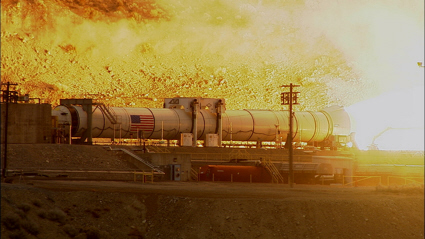
The booster for NASA's Space Launch System rocket fires for a two-minute test on March 11 at the Orbital ATK test facility in Promontory, Utah. The booster was the largest, most powerful rocket booster ever built and produced about 3.6 million pounds of thrust. The test was one of two that will qualify the booster for use with NASA's Space Launch System (SLS). The SLS will send the Orion spacecraft to deep space destinations, including an asteroid and Mars. Image: NASA
(MAR 12) Imagine taking the world's most powerful radio telescope, used by scientists around the globe, and piping a nearly continuous data stream into your research laboratory. More
(MAR 4) The largest, most powerful booster ever built for NASA's new rocket, the Space Launch System (SLS), will fire up for a ground test at 11:30 a.m. EDT (9:30 a.m. MDT) Wednesday, March 11, at Orbital ATK Propulsion Systems' test facilities in Promontory, Utah.
The two-minute static test is a significant milestone for the SLS as part of NASA's journey to Mars, and follows years of development. It is one of two ground tests to qualify the booster for flight. A second test is planned for early 2016. Once qualification is complete, the hardware will be ready to help send the rocket, along with NASA's Orion spacecraft, on its first flight test.
A public viewing area is available along State Road 83 North approximately 20 miles west of Corinne, Utah. The gate to the public viewing area opens at 7 a.m. MDT Wednesday. Overflow parking is available, if needed.
For NASA TV streaming video, downlink and schedule information, visit:
NASA

Bang Kachao, an area that escaped development forms a green oasis amid the urban sprawl of Bangkok, Thailand. The Operational Land Imager (OLI) on Landsat-8 recorded this natural-color view of Bang Kachao during a recent daylight pass over the region. The OLI instrument was built by Colorado-based Ball Aerospace and Technologies. Landsat-8 was launched from Vandenberg AFB, Calif. in early 2013. Image courtesy of NASA and USGS
(MAR 1) Observers across a wide area of the Southwest were treated to an unusual light show last Wednesday morning thanks to an Air Force experiment launched from White Sands, NM.
A Terrier-Black Brant sounding rocket lifted off from White Sands Missile Range at 5:26 a.m. Mountain Standard Time and released small amounts of samarium vapor in near-Earth space to create clouds of plasma, or ionized gas. The purpose of the Air Force Research Laboratory experiment was to study the processes responsible for formation of the Earth's ionosphere.
According to media reports, the experiment produced a purple steak or pink cloud that was seen in Arizona and New Mexico.
Brian Webb
(FEB 17) SANTA BARBARA, Calif. - The gas giant Jupiter will be the star attraction at this month's free public viewing on Friday, Feb. 20, beginning at 6:30 p.m. and lasting several hours at the Westmont Observatory. In case of inclement or overcast weather, please call the Telescope Viewing Hotline at (805) 565 -6272 and check the Westmont website to see if the viewing has been canceled.
Rising in Leo, Jupiter will be in good position for viewing in the early evening. "Since Jupiter has passed through opposition recently - and now rising just before the sun sets - we may be lucky enough to see a shadow cast onto its surface by one of its large moons," says Thomas Whittemore, Westmont physics instructor.
The viewing may also feature the Orion Nebula, M42. "Orion is high in the sky by 8 p.m.," Whittemore says. "If the seeing is good this evening, we may be able to see six of the Trapezium stars in the heart of the nebula with Westmont's 24-inch reflector telescope."
The Milky Way, which contains a number of open clusters, is high in the winter sky and a popular viewing subject. "One of my favorites, M35 in Gemini, is a chain of stars with all sorts of subtle color variations," he says. "This particular object will be best viewed in Westmont's 8-inch refractor."
Mars and Venus are putting on quite a show in the west, although their alignment will make them unobservable with Westmont's telescopes. "By Friday evening, they will be about a degree or so apart in this chance alignment," he says. "The proximity of the creamy-colored (and bright) Venus with the fiery-red (and much dimmer than Venus) Mars yields a wonderful color contrast between the two objects. The public will be able to see this pairing early in the evening and with their bare eyes, but by 8 p.m. both objects will have set in the southwest."
The observatory opens its doors to the public every third Friday of the month in conjunction with the Santa Barbara Astronomical Unit, whose members bring their own telescopes to Westmont for the public to gaze through. The Keck Telescope is housed in the observatory between Russell Carr Field and the track and field/soccer complex. Free parking is available near the baseball field.
Westmont College
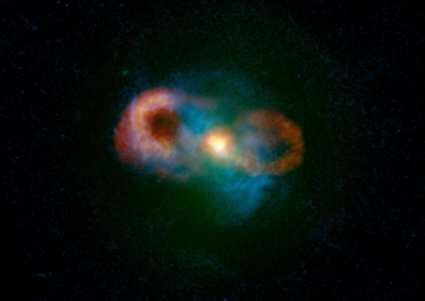
The Teacup Galaxy reveals otherwise hidden detail in this composite image created from radio observations by the Very Large Array radio observatory near Socorro, N.M. and optical images. Green colors show the starlight, blue colors show the gas, and the red/yellow colors show the radio emissions. The bright yellow blobs in the center of the image show where the radio "jets," launched by the black hole, are driving into the gas and accelerating it to 200,000 miles per hour (1,000 kilometers per second. The giant bubbles also are being inflated by a central black hole. This demonstrates that the central black hole is having a catastrophic effect on the galaxy. Credit: C. Harrison, A. Thomson; Bill Saxton, NRAO/AUI/NSF; NASA
(FEB 12) LONG BEACH, Calif. - Virgin Galactic, the privately-funded space company owned by Sir Richard Branson's Virgin Group and Abu Dhabi's Aabar Investments PJS, is pleased to announce it has leased a new 150,000 square foot facility that will house design and manufacturing of the company's small satellite launch vehicle, LauncherOne.
LauncherOne is a new two-stage orbital launch vehicle being designed by Virgin Galactic specifically to launch commercial or governmental satellites that weigh 500 pounds (225 kilograms) or less. Much like SpaceShipTwo, the company's reusable vehicle for space tourism, LauncherOne is designed to be launched from the WhiteKnightTwo carrier aircraft, giving customers the ability to avoid crowded and expensive launch ranges while also picking the launch location best suited for their mission. Located at the Long Beach Airport, this new facility will allow easy transportation of rockets and of customers' satellites using WhiteKnightTwo.
With a launch price aimed to be the lowest in the nation or perhaps the world, LauncherOne has already attracted the interest of numerous small satellite manufacturers and operators. Among them is the recently announced OneWeb project designed to deliver broadband services to areas of the world not currently served by terrestrial networks. This and other ambitious projects are expected keep the Long Beach facility busy for many years to come.
Virgin Galactic
(FEB 2) LAS CRUCES, N.M. - Scientists in January announced a final data release for the third phase of the Sloan Digital Sky Survey that includes information to allow researchers to construct a three-dimensional chemical map of the Milky Way galaxy. More
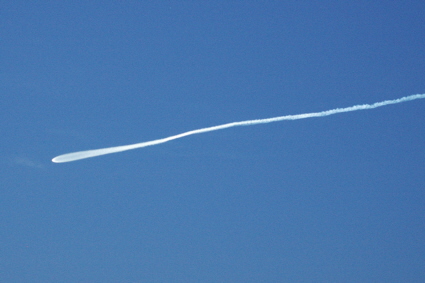
A Delta II rocket carrying NASA's SMAP satellite and several smaller spacecraft climbs into orbit following liftoff from Vandenberg AFB on Saturday, January 31. The dawn event was visible to the unaided eye over a wide area. The Webmaster recorded this view of the launch from Ventura County, some 100 miles east-southeast of the launch site. Copyright 2015, Brian Webb
(JAN 31) Vandenberg Air Force Base, Calif. - A United Launch Alliance (ULA) Delta II rocket carrying the Soil Moisture Active Passive (SMAP) payload for NASA lifted off from Space Launch Complex-2 at 6:22 a.m. PST today. This launch marks ULA's second launch of 13 planned for 2015, and the 93rd successful mission since the company was formed.
"Congratulations to the NASA Launch Services Program team, JPL and all of our mission partners on today's successful launch of the SMAP satellite," said Jim Sponnick, ULA vice president, Atlas and Delta Programs. "It is our honor to launch this important Earth science mission to help scientists observe and predict natural hazards, and improve our understanding of Earth's water, energy and carbon cycles."
The SMAP mission was launched aboard a Delta II 7320 configuration vehicle featuring a ULA first stage booster powered by an Aerojet Rocketdyne RS-27A main engine and three Alliant Techsystems (ATK) strap-on solid rocket motors. An Aerojet Rockedyne AJ10-118K engine powered the second stage. The payload was encased by a 10-foot-diameter composite payload fairing.
The SMAP mission is NASA's first Earth-observing satellite mission designed to collect global observations of surface soil moisture and its freeze/thaw state, data that have broad applications for science and society.
United Launch Alliance
(JAN 22) VANDENBERG AIR FORCE BASE, Calif. - Team Vandenberg is scheduled to launch a NASA satellite on a United Launch Alliance rocket from Space Launch Complex-2 here Thursday, Jan. 29, at 6:20 a.m. PDT.
The Delta II rocket will carry NASA's Soil Moisture Active Passive; the first Earth-observing satellite.
Col. Shane Clark, 30th Space Wing vice commander, will be the Launch Decision Authority.
"We are excited to take on our first launch of 2015," said Clark. "Every launch takes dedication and teamwork. I am extremely proud of the team and our strong partnership with NASA. Everyone involved has been working tirelessly to ensure this is a safe and successful launch."
SMAP is designed to collect global observations of surface soil moisture and its freeze/thaw state. High resolution space-based measurements of soil moisture and whether the soil is frozen or thawed will give scientists a new capability to observe and predict natural hazards of extreme weather, climate change, floods and droughts, and will help reduce uncertainties in the understanding of Earth's water and carbon cycles.
Vandenberg AFB
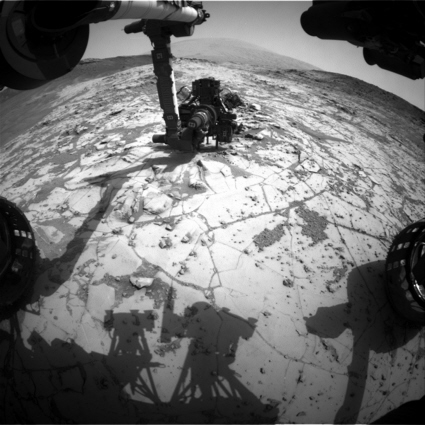
The drill on NASA's Curiosity Mars Rover rests in position for a drill test in this image taken on January 13. The test was used to assess whether a rock target called "Mojave" was appropriate for full-depth drilling to collect a sample. A key appeal of this target is an abundance of crystal-shaped features. The Jet Propulsion Laboratory in Pasadena, Calif. manages the Curiosity mission for NASA's Science Mission Directorate. JPL also designed and built the Curiosity rover. Image Credit: NASA/JPL-Caltech
(JAN 16) TUCSON, Ariz. - NASA's Kepler Space Telescope, despite being hobbled by the loss of critical guidance systems, has discovered a star with three planets only slightly larger than Earth. More
(JAN 8) SANTA BARBARA, Calif. - The Comet Lovejoy will tantalize stargazers at this month's free public viewing of the stars with Westmont's powerful Keck Telescope on Friday, Jan. 16, beginning at 6:30 p.m. and lasting several hours at the Westmont Observatory. In case of inclement or overcast weather, please call the Telescope Viewing Hotline at (805) 565-6272 and check the Westmont website to see if the viewing has been canceled.
The Comet Lovejoy, C/2014 Q2, is making its closest approach to earth, 44 million miles away. "I've been watching it from our back yard for the last week and it's a bright one," says Thomas Whittemore, Westmont physics instructor. "It's almost a naked-eye object at this point, and at the public viewing, there will be no moon to interfere with the comet's brightness. I have yet to see a tail on Lovejoy, but maybe we will get lucky with Westmont's 8-inch refractor telescope."
Whittemore says he will use the Keck Telescope, a 24-inch reflector, to zoom in on the Orion Nebula. "This 1,400 light-year-distant stellar nursery is always a wintertime treat," he says.
Weather permitting, the viewing may also include the Crab Nebula in Taurus. "Viewed across the world in 1054, there are many records of this supernova explosion," Whittemore says. "Today we see the remnants of the exploded star as Messier 1, the Crab Nebula. To me, even through a moderate-sized telescope, the nebula's structure looks like a splash of milk."
The observatory opens its doors to the public every third Friday of the month in conjunction with the Santa Barbara Astronomical Unit, whose members bring their own telescopes to Westmont for the public to gaze through. The Keck Telescope is housed in the observatory between Russell Carr Field and the track and field/soccer complex. Free parking is available near the baseball field.
Westmont College

The 4-mile (6.5 kilometer) El Progreso pier in Mexico's Yucatan and considerable offshore detail are visible in this recently released view from Landsat-8's Operational Land Imager. Built over a wide and shallow continental shelf, the pier's length is necessary to allow docking by larger ships. Landsat-8 was launched in 2013 from Vandenberg AFB. Image credit: NASA/U.S. Geological Survey
(JAN 4) Sky watchers have a good opportunity to see the elusive planet Mercury at dusk this month. Since Mercury's orbit is so close to the Sun, the planet never strays far from the Sun's glare as seen from Earth, making Mercury difficult to find and identify.
However, this month, Mercury climbs out of the Sun's glare and is easy to spot and identify thanks to a bright celestial landmark. From January 2 to 16, Mercury lies within 5 degrees of the much brighter planet Venus.
To find Mercury, look low in the west-southwest 30 to 50 minutes after sunset. Locate silvery-white Venus. Then look below and to the right of Venus for Mercury, which resembles a much fainter, star-like object.
The pairing of the two planets is most impressive on the evening of January 10 when Venus and Mercury are separated by slightly more than 1/2 of a degree.
Although Mercury and Venus appear to be close to one another this month, their apparent proximity is an illusion. The two planets are lined up in such a way that they happen occupy the same part of the sky as seen from Earth. In reality, the planets are separated by many millions of miles.
Brian Webb
Copyright © 2016, Brian Webb. All rights reserved.